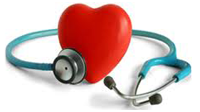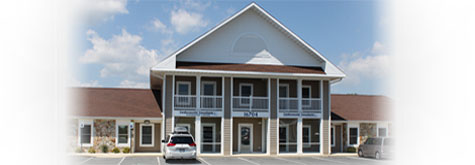Myocardial Infarction
WHAT IS IT?
Myocardial infarction, commonly referred to as a heart attack, occurs when one or more coronary arteries become suddenly blocked, resulting in heart muscle death.
Also Known As: Acute Myocardial Infarction, Heart Attack
Basic Facts
Myocardial infarction, commonly referred to as a heart attack, occurs when one or more coronary arteries become suddenly blocked, resulting in heart muscle death.
Typical symptoms of a myocardial infarction include chest pressure or pain, shortness of breath, profound sweating, nausea, vomiting, and/or fainting.
Myocardial infarction results from coronary artery disease (CAD), which is an accumulation of plaque inside the coronary blood vessels.
When one of these plaques rupture, a clot forms rapidly at the site and causes a sudden obstruction of blood flow in the coronary artery.
Without immediate treatment, a myocardial infarction can cause permanent damage to the heart muscle and chaotic, abnormal heart beating. Both conditions can cause death.
Because of the seriousness of a myocardial infarction, seeking immediate medical attention is very important.
A video about Acute Myocardial Infarction.
A More Detailed Explanation
Myocardial infarction, also known as MI or heart attack, is a condition when one or more of the coronary arteries which supply oxygen-rich blood to the heart muscle become suddenly blocked, resulting in heart muscle death.
In general, blockages result from plaques made of cholesterol and fats building up in the coronary arteries. The accumulation of this plaque is known as coronary artery disease (CAD). In many cases, the accumulation of plaque is a gradual process and can produce symptoms of chest pain or pressure known as angina pectoris, or angina.
In contrast to this gradual accumulation of plaque, a myocardial infarction occurs when a plaque suddenly ruptures, causing a rapid accumulation of clotting factors at the rupture site. This results in a sudden obstruction of blood flow in the coronary artery. This sudden obstruction prevents any blood from reaching the heart muscle. Without this vital supply of oxygen-rich blood, the heart muscle begins to die. The longer the obstruction persists, the greater the amount of heart muscle that dies.
Myocardial infarction is a medical emergency . Without treatment, substantial portions of the heart can be permanently damaged, preventing efficient pumping of blood to the rest of the body, and resulting in congestive heart failure. In addition, a myocardial infarction can cause ventricular arrhythmias, or rapid and chaotic beating of the lower chambers of the heart. In many cases, ventricular arrhythmias can cause cardiac arrest, stopping blood flow to the body and brain. If that happens, brain damage and death can result within minutes.
Because of these serious and potential life-threatening complications of a myocardial infarction, seeking immediate medical attention is very important.
Symptoms
Myocardial infarction symptoms are typically sudden in nature, and often persist for more than 20 minutes. Occasionally, symptoms can 'come and go.' Typical symptoms include:
Chest pain or pressure
Chest tightness
Chest pain, pressure, or tightness that extends from the chest to the neck, throat, jaw, shoulder and/or arm
Chest discomfort just below the breastbone
Chest burning, similar to heartburn or indigestion
Shortness of breath
Because a myocardial infarction usually occurs without warning, it can cause severe anxiety. It can also cause other symptoms such as nausea, lightheadedness, fainting, or profuse sweating.
Many people having symptoms of a myocardial infarction are reluctant to seek medical attention because they think the pain they are feeling is due to something else, are afraid or unwilling to admit that the pain could represent something serious, or are reluctant to 'cause a scene' by calling an ambulance, going to the hospital, and then discovering it is a false alarm. However, by delaying medical attention and treatment, patients are at much higher risk for permanent heart damage and death. Accordingly, if patients are having symptoms that could represent a myocardial infarction, they should always seek immediate medical attention by dialing 911.
Risk Factors
Myocardial infarctions result from coronary artery disease (CAD). Thus, risk factors for the development of CAD are also risk factors for myocardial infarctions:
Smoking
Having high cholesterol levels
Not exercising regularly
Having hypertension, or high blood pressure
Eating a diet high in saturated fat and cholesterol
Having diabetes mellitus
Being more than 30 percent over one's ideal weight
Using stimulant or recreational drugs, such as cocaine or amphetamines
Having family members (especially parents or siblings) who have had coronary artery disease (CAD), myocardial infarctions, or strokes
Diagnosis
To diagnose a myocardial infarction, a physician will conduct a thorough medical history (including a complete description of a patient's symptoms), conduct a physical exam, and perform one or more of the following tests:
Electrocardiogram (ECG)
ECG tests monitor the electrical activity of the heart. Physicians look for certain patterns on electrocardiograms that suggest myocardial infarction. In many cases, the ECG can reveal which part of the heart is damaged, the extent of that damage, and whether the heart attack has caused an abnormal heart rhythm.
Cardiac blood tests
Cardiac blood tests look for evidence that a myocardial infarction has occurred and that heart muscle has died. In some cases, several blood tests have to be checked over a period of several hours, since evidence of a myocardial infarction can take some time to appear in the blood.
Echocardiography
An echocardiogram, or echo, is a test that uses ultrasound, or high-frequency sound waves, to take a moving picture of the heart. The physician uses the echocardiogram to evaluate the structure and function of a patient's heart and surrounding vessels. During a myocardial infarction, echocardiograms can demonstrate the location and extent of heart damage.
Cardiac catheterization and angiography
Physicians may recommend cardiac catheterization and angiography, especially if the ECG and/or cardiac blood tests indicate the presence of a myocardial infarction. In this test, a catheter (a very thin, flexible tube) is inserted into an artery in the groin or arm and advanced into the heart. When the catheter is positioned near the arteries that supply blood to the heart, the physician injects a contrast dye. As the dye travels through the arteries, X-ray pictures are taken to see how well blood flows through the arteries, and if there are any blockages that are causing a myocardial infarction.
Treatment
Treatment for myocardial infarction focuses on three goals: treating the myocardial infarction by interrupting the clotting process and opening blocked coronary arteries, managing any of the complications that can occur with a myocardial infarction, and treating the underlying coronary artery disease (CAD) so as to prevent future myocardial infarctions.
Treating the myocardial infarction
The most important factor in treating a myocardial infarction is time. A myocardial infarction is a medical emergency, and medical attention is needed as soon as symptoms begin . Delays in receiving treatment can result in permanent heart damage and death. Thus, patients experiencing symptoms of a myocardial infarction should call 911 immediately. Patients should not drive themselves, or have family or friends drive them, to a hospital - it is essential that trained medical personnel and ambulance equipment are available to assist the patient during the transport to the hospital.
Interrupting the clotting process
Since most myocardial infarctions occur when clotting factors accumulate at the site of a ruptured plaque, medicines are needed to stop the accumulation. Patients who begin to experience the symptoms of a myocardial infarction and who are not taking aspirin should immediately chew an aspirin, which blocks clotting factors in the blood. Chewing the aspirin, rather than swallowing it whole, accelerates the body's process of absorbing the aspirin. Once the patient is at the hospital, other medicines to block the body's clotting process may be administered, including heparin, clopidogrel, and platelet glycoprotein (GP) IIb/IIIa receptor blocker medications.
Opening blocked coronary arteries
Opening blocked coronary arteries to restore blood flow to the heart as soon as possible can prevent or limit damage to the heart muscle and can also decrease the chance of a repeat myocardial infarction. To open blockages, physicians can either use a medicine to dissolve the clot or use a procedure called coronary angioplasty to open the blocked artery.
Thrombolytic medicines are medicines that are administered via an injection and dissolve a thrombus that is blocking blood flow in a coronary artery. In coronary angioplasty, a balloon-tipped catheter is inserted into a blood vessel in the arm or groin and is advanced through blood vessels and into the heart. When the catheter reaches the blockage in the coronary artery, the physician inflates the balloon on the tip of the catheter. The balloon is inflated and deflated, pressing against the plaque buildup on the walls of the coronary artery and increasing the diameter of the artery. Often, a metal-mesh tube, known as a stent, is placed in the artery to keep it open. The stent remains permanently in the coronary artery, and the balloon and catheter are removed at the end of the procedure.
The use of thrombolytic medicines or coronary angioplasty will depend on the capabilities of the hospital where the patient is receiving care. However, regardless of the method used, the goal is to use either strategy as soon as possible in order to open the blocked artery, restore blood flow, and prevent or minimize permanent heart muscle damage.
Managing complications
The most common complications from myocardial infarctions are damage to the heart muscle and abnormal heart rhythms. The longer it takes to open a blocked artery with medications or coronary angioplasty, the more likely it is for these complications to occur. However, even after the blocked artery has been opened, patients remain at risk for these complications, especially in the first several days after a myocardial infarction. Thus, myocardial infarction patients are usually admitted to the hospital and observed for several days in a specialized unit called the coronary care unit, which has staff specifically trained to care for patients with myocardial infarctions. Various tests, including echocardiograms and ECGs (see above), are used to look for heart muscle damage and abnormal heart rhythms.
In addition to admission to the coronary care unit and testing, various medications are also given to patients who have had a myocardial infarction in order to minimize complications and prevent future myocardial infarctions:
Anti-platelet medications
Platelets can be thought of as tiny plugs which circulate in the blood, and play a large role in forming clots at the site of ruptured plaques. Anti-platelet medications, such as aspirin and clopidogrel (Plavix®), inhibit the clotting action of platelets, and thus are very useful in preventing future myocardial infarctions.
Lipid-lowering agents
Cholesterol-lowering medications, such as statins, and other lipid therapies have been associated with marked reduction in future cardiac events by stabilizing the remaining cholesterol containing plaques. Almost all patients recovering from a myocardial infarction will benefit from long-term lipid therapy.
Beta-blockers
Beta-blockers slow the heart rate and decrease the adverse effect of excessive adrenaline on the heart. The use of beta-blockers after a myocardial infarction has been associated with improved survival.
Angiotensin converting enzyme (ACE) inhibitors and angiotensin II receptor blockers (ARBs)
ACE inhibitors and ARBs are medications that reduce the resistance the heart has to pump against. They have been effective in preventing heart enlargement after large myocardial infarctions.
Coronary artery procedures
Finally, depending on the number and distribution of blockages in the coronary arteries, procedures to open or bypass these blockages may be useful, in addition to the medications, in preventing future myocardial infarctions. These procedures include coronary angioplasty, as described above, or coronary artery bypass grafting (CABG) surgery. CABG surgery is an open-heart surgery, performed by cardiac surgeons. After the patient is put to sleep, the chest is surgically opened and new, unclogged blood vessels, taken from a person's leg or chest, are used to reroute, or bypass, the plaque blockages.
Treating coronary artery disease (CAD)
CAD is treated with both medications and lifestyle modifications.
Coronary artery disease (CAD) medications
Aspirin
As described above, aspirin prevents platelets from accumulating at the site of plaque that has broken apart. Patients with CAD need to take this medication indefinitely to lower their risk of future myocardial infarctions.
Lipid-lowering agents
As described above, cholesterol-lowering medications, such as statins and other lipid therapies, have been associated with marked reductions in future cardiac events by stabilizing plaques and decreasing their risk of rupture. Almost all patients who have experienced a myocardial infarction will benefit from long-term lipid therapy. Different therapies may be required based on the patient's individual cholesterol levels.
CAD risk factor treatments
Medications that specifically treat the risk factors for CAD (e.g. high blood pressure, diabetes) are needed to control the growth of plaques. Depending on an individual patient's situation, a physician will prescribe the necessary medications for this.
Coronary artery disease (CAD) lifestyle modifications
Healthy diet
Patients with coronary artery disease (CAD) who consume diets lower in saturated fat, cholesterol, and calories can improve their cholesterol levels. In addition, patients with CAD who consume a diet rich in fruits, vegetables, and low-fat dairy products and low in red meat and processed foods (known as the DASH diet) can lower their blood pressure.
Exercising regularly
Aerobic exercise for 20 to 30 minutes every day can reduce blood cholesterol and improve blood pressure. Patients who have had a myocardial infarction should check with their physician before beginning an exercise program.
Quitting smoking
Smoking accelerates the progression of CAD, diminishes the blood's capacity to carry oxygen to body tissues, damages the blood vessel walls, and makes the blood more likely to clot, leading to myocardial infarction and stroke. The nicotine and other chemicals in tobacco smoke also raise blood pressure and increase the heart rate. By quitting smoking entirely, the risk of myocardial infarctions is greatly reduced.
Losing weight
Losing as few as 5 to 10 pounds can help decrease high blood pressure and improve cholesterol.
Recovery
After a myocardial infarction has been treated and the patient is ready to go home from the hospital, the physician may recommend that the patient enroll in a cardiac rehabilitation program. These programs help patients who have suffered from a myocardial infarction make and commit to the medication and lifestyle changes that can enhance the effects of medical treatment and help prevent further myocardial infarctions. They also oversee a gradual resumption of physical activity, and can be a valuable source of information and support for patients and their families.
Myocardial infarction is a serious medical event, and it often requires substantial changes in a patient's life in order to prevent future myocardial infarctions. Often, patients may become 'blue' or depressed during the weeks and months following a myocardial infarction. If this occurs, it is important to discuss these feelings with a physician to ensure that they do not interfere with taking the necessary steps to prevent future myocardial infarctions.
Although myocardial infarctions are serious conditions, many therapies are available to minimize heart damage, prevent future myocardial infarctions, and ensure a long and healthy life. In order to achieve these goals, patients and families should educate themselves about cardiac health, work with their physicians, and adhere to all prescribed medication and lifestyle therapies.
Sex after a Heart Attack
Many patients who have had a myocardial infarction are concerned about whether sexual activity endangers their heart. Contrary to a popular belief, sexual activity does not cause myocardial infarctions. As a general rule, most people can resume sexual activity within 2 weeks after being treated for a heart attack. However, patients should discuss resuming sexual activity with their physician before doing so.
If you have other questions, please email Mary Zook at mary.zook@cvcde.com. If you have urgent questions, please call 911 or call our office at 302-644-1233




